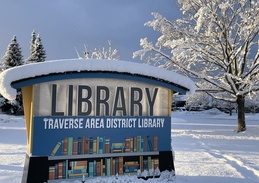Blunt Bzdok
Feb. 14, 2010
Blunt BzdokTC’s mayor wonders‘who’s in charge here?’By Anne Stanton
Last week, about 130 Traverse City residents gathered at a city
commission meeting, most of them angry over a pricey plan to redo 8th
Street that doesn’t include bike lanes.
The pushback was powered, in part, by Mayor Chris Bzdok’s
blog—planfortc.com. Emails flew around the city about the issue, most
of them ending with a message to check out the blog.
In it, Bzdok bluntly outlined what happened and why. He wrote that the
city engineer decided not to include bike lanes or new pedestrian
crossings, and allegedly interfered when the city sought a second
opinion from a local engineering firm.
“I’ll be the first to admit it: I get emotional when it comes to bike
lanes. But the issue is, who’s in charge here?” Bzdok wrote on his
blog.
Bzdok, elected in November, provides lots more detail, and it’s worth
spending time reading the many elements of his blog. As the most
publicly outspoken mayor Traverse City in years, he’s getting
simultaneously criticized and praised for spilling the gritty details
of city business and going after an employee by name.
We asked Mayor Bzdok to explain his style and his vision:
NE: Someone wrote on your blog that the “tight pants” bike crowd was
dictating policy. The writer considered biking on 8th Street as
suicide even with a bike lane. City engineer Tim Lodge defended his
decision not to include bike lanes on the city’s main artery, saying
bikers could easily detour to Washington Street, Hannah Street, or the
TART trail; plus a bike lane would also involve cutting up to 60 trees
and condemning property for the road widening.
Bzdok: The master plan says what it says (see footnote). Dan O’Neil
said it best last night, “This debate was over a long time ago. “
Everyone knows that we want 8th Street to go a step closer to a
neighborhood street, not a step closer to South Airport Road. So
hopefully, when we spend so much time and energy writing plans and
policies, we can expect they’ll be followed.
The master plans, the old and the new, don’t just talk about bike
lanes. They talk about a calmer street, with better pedestrian
crossings, designed for slower speeds. Right now, you have a 25-mile
speed limit, but some people go 40 in some stretches. That causes
noise and vibration in the houses, makes it difficult to cross the
street, and makes it dangerous for bicycles. If you calm the street
down, and design it to be more neighborhood friendly, you’ll move just
as many vehicles, but at the speed limit. If people go 25, not 40, it
won’t take much longer to travel. It’s three miles long; it’s a
difference of five minutes. But it’s a huge difference to people and
businesses along there.
NE: And you consider this an economic development strategy?
Bzdok: Yes –look at what happened on Woodmere. They fixed it up.
People built cottage-style developments and offices near the library.
Stuff is happening on Woodmere. Eighth Street is much more of a main
artery. So make it a nice street that still moves cars, but at the
speed limit. Then more people will fix up their houses, their property
values will rise with nice street-scaping, there will be more foot
and bike traffic. And that’s good for retail. It’s not rocket science;
it’s not anything I invented. Everybody wins.
NE: You’ve been criticized for blaming the city engineer by name on
your blog and in the newspaper.
Bzdok: I did not in any way, shape or form sign up to do the kinds
of things I’ve been doing over the last two weeks. This is, I hope, a
one-time situation. But in my judgment it simply had to be done. I
tried to deal with things internally for two months and was
unsuccessful. My sense was the public was going to be angry when this
came to light, which turned out to be correct. I accept the criticisms
some people have made. That should not be the m.o. or standard
operating procedure of the citizen mayor of Traverse City. But we were
in a situation where there was no other path open to us. There was no
perfect option. I mostly hope for the future, that there will be a
partnership between city commission and city staff.
NE: The city engineer said the city commission took no less than five
actions on this project, but I understand they were consent items—a
rubber stamping of sorts (see footnote). The approvals involved
temporary asphalting of 8th Street, money for a soil survey, approval
of the MDOT stimulus contract, but never a plan, drawing, design,
contract, or actual job description. As for public notice, there were
announcements of staff meetings, but people never saw any notice that
a significant 8th Street project was planned. It seems City Manager
Ben Bifoss should have flagged this for all of us. He knows the master
plans. He oversees the city engineer. He knew about the new
“infrastucture policy” that was being created with a “complete”
approach to street redesign. He’s in charge. Shouldn’t you hold him
accountable?
Bzdok: Having spent three years in city government, I can tell you
that the city manager is an incredibly difficult job. There’s a
constant balancing act with the city commission, which implements the
will of the people, and the department heads, who have the expertise
to operate the city. So you have one foot in local politics and one
foot in the nuts and bolts of operating the city. I believe, all in
all, the city manager has done a masterful job of that balancing act.
He’s pursuing saving the city money, and then using those dollars to
meet infrastructure priorities.
NE: What was the outcome of last week’s meeting?
Bzdok: We talked about the risk of losing $230,000 in stimulus money
plus other MDOT (Michigan Department of Transportation Money),
relative to water and sewer; the total could be up to the mid
$400,000s. The direction of the City Commission is to go forward with
the project as scheduled this spring, while attempting through
legislators and other contacts, to get some flexibility from the state
and federal transportation agencies to introduce pedestrian and
bicycle friendly elements into the plan while it’s constructed. And if
that fails, then to hire an engineering firm to design those elements
into the project basically as a retrofit after the project is closed
out.
NE: A retrofit. What does that mean?
Bzdok: That means you’ll pour the curbs, let them dry. Let the agency
put a stamp on a piece of paper, then you would go back in and
demolish the curbs and redo them. That’s what we’re looking at because
of the dysfunctionality of this situation.
NE: What are you going to do so this doesn’t happen again?
Bzdok: When I got sworn in as mayor, I did something a little cheeky.
I made an inaugural speech of sorts, which is also on my website. The
gist of it is, the city will more effectively serve its residents if
we seek their direction at the outset as opposed to putting things out
for their reaction at the end of the process. My dad says Gordie Howe
never looked as if he was going fast because he never wasted a stride.
The situation we’re in is the opposite of that. We skated up to a
line, and now we have to turn this way and that way, and react to the
residents. That’s why I have the planfortc.com site to put things out
there constantly so we know what the public wants early in the
process. But I can only do so much.
NE: What’s your vision for the city?
Bzdok: I believe that city commissioners are resident advocates for
our neighbors. Why do people want to live here? We know from the
residential task force report and from our meetings with neighborhood
presidents that it’s all the same stuff: slower traffic in and around
neighborhoods, walkability, bikeability, cost-effective delivery of
services, good paying jobs, parks, and in-town schools. These are the
reasons people want to live in the city.
NE: Moving onto another issue, city residents cope with high taxes, in
part, because the city’s 14,532 taxpayers are paying for public
resources used by the region’s 131,342 residents and thousands of
visitors. What’s the answer?
Bzdok: I believe we can deliver services more cost effectively than
we do right now. There’s a COFAC report on my blog that really goes
into this, and two members of that group are now city commissioners.
I’m also aware of the condition of our streets and infrastructure and
the kind of price tags in dealing with that. It’s myopic to just say,
if we tweak here and there, suddenly we can give people a bunch of
money back. We’re going to spend $1.9 million to fix two miles of
street. And 40 of our 76 miles in the city are in poor condition, and
that doesn’t include gravel streets and streets without sidewalks,
like many in Traverse Heights and elsewhere. So you can see how high
the hill is we have yet to climb.
Specifically, the master plan says: “East Eighth Street, Fourteenth
Street, Division Street, Garfield Avenue, East Front Street and
Peninsula Drive are examples of roadways where the needs of the
pedestrian and bicyclist must be taken into consideration. Roadway
improvement designs must consider the needs of the pedestrian and
bicyclist by incorporating sidewalks and bike lanes.”
The consent calendar specifies: “The purpose of the consent calendar
is to group non-controversial items together to be dealt with in one
motion without discussion.”
Trending

Our Top Stories of 2025
Each year, we look back at the stories we’ve shared over the last 12 months and pull together the ones that got the mo… Read More >>
Winter Break at the Library
Trying to keep the kids busy while school is out? Head to the library! Dec. 22, take your 12+ tweens and teens to the Mesick… Read More >>
Umbo Is Coming...to The Little Fleet
Winter isn’t just coming—it’s already here. But if you want a break from the December blues, head to The L… Read More >>


